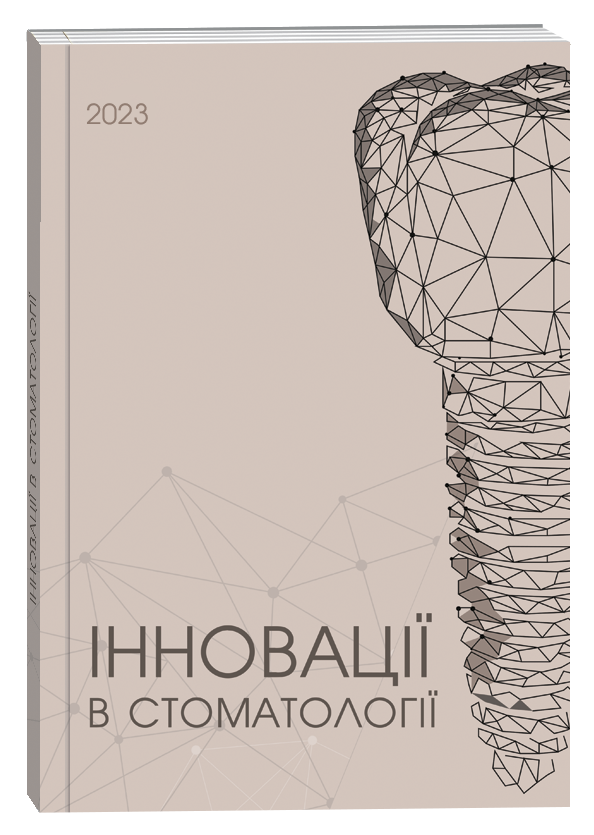EVALUATION OF THE ACCURACY OF FIXING THE CENTRAL RATIO OF THE JAWS DEPENDING ON THE REGISTRATION METHOD
DOI:
https://doi.org/10.35220/2523-420X/2024.2.10Keywords:
TMJ, central jaws relation, central occlusion, reference position, articulator, virtual articulator, wax plate, Aluwax, jig, leaf calibrator, gnathometer, condylographyAbstract
The central ratio of the Jaws is one of the most controversial issues in dentistry. There are even dozens of definitions of this term in the professional literature. It is also known about a considerable number of methods and techniques for fixing it, each of which has its own characteristics, advantages and disadvantages. At the same time, the search and registration of the position of the lower jaw, which could be used as a starting point for orthopedic or orthodontic treatment, is perhaps the most urgent problem. The purpose of this study. Analyze the accuracy of fixing the central shelep ratio using the most well-known clinical methods. Materials and methods. The study group included 10 patients aged 25 to 65 years, equally male and female, who were diagnosed with digital condylography. The distribution of patients according to the ratio of dentition rows according to Engle classification was as follows: 3 patients had the 1st Class, 1-the 2nd Class of the 1st subclass, 4-the 2nd Class of the 2nd subclass, and 2 belonged to the 3rd Class. Models of the upper jaw were cast to the Gamma Reference SL articulator using a condylograph and a kinematic facial Arch in the true articulated axis of the joints. Registration of the central ratio based on electronic condylography data was used as a control. Conclusions. In all the studied patients, a displacement of the jaw was detected under the influence of occlusion from the state of the central ratio, and the Delta can vary individually and exceed 1 mm. The accuracy of recording the central ratio depends on the chosen technique, as well as on the type of ratio of the patient’s jaws. There is no universal way to register the central ratio; its choice should be based on the specific clinical situation and individual characteristics of each patient. The data obtained can be useful for choosing the optimal method for recording the central jaw ratio in a specific clinical setting.
References
Rudolf, Slavicek. (2019). The Masticatory Organ: Functions and Dysfunctions – Klosterneuburg; Gamma, Med. Wissenschaftliche Fortbildungs Ges.m.b.H,.
Rudolf, Slavicek (2015). Concepts in Oral Medicine. Klosterneuburg; Gamma, Med. Wissenschaftliche Fortbildungs Ges.m.b.H.
Yadav, S., Yang, Y., Dutra, E.H., Robinson J.L., & Wadhwa, S. (2018). Temporomandibular Joint Disorders in Older Adults. J Am Geriatr Soc, 66(6), 1213-1217. doi: 10.1111/jgs.15354.
Chang, T.H., Yuh, D.Y., Wu, Y.T., Cheng, W.C., Lin, F.G., Shieh, Y.S., Fu, E., & Huang, R.Y. (2015). The association between temporomandibular disorders and joint hypermobility syndrome: a nationwide populationbased study. Clin Oral Investig, 19(8), 2123-32. doi: 10.1007/s00784-015-1422-7.
Nassar, M.S., Palinkas, M., Regalo, S.C., Sousa, L.G., Siéssere, S., Semprini, M., Bataglion, C., & Bataglion, C. (2012). The effect of a Lucia jig for 30 minutes on neuromuscular re-programming, in normal subjects. Braz Oral Res., 26(6):530-5. doi: 10.1590/s1806-83242012005000026.
Santosa, R.E., Azizi, M., Whittle, T., Wanigaratrne, K., & Klineberg, I.J. (2006). The influence of the leaf gauge and anterior jig on jaw muscle electromyography and condylar head displacement: a pilot study. Aust Dent J. 51(1):33-41. doi: 10.1111/j.1834-7819.2006.tb00398.x.
de Baat, C., van’t Hof, M., van Zeghbroeck, L., Ozcan, M., & Kalk, W. (2007). An international multicenter study on the effectiveness of a denture adhesive in maxillary dentures using disposable gnathometers. Clin Oral Investig. 11(3):237-43. doi: 10.1007/s00784-007-0109-0.
de Kanter, R.J.A.M., Battistuzzi, P.G.F.C.M., & Truin, G.J. (2018). Temporomandibular Disorders: “Occlusion” Matters! Pain Res Manag., 2018, 8746858. doi: 10.1155/2018/8746858.
Vlăduțu, D., Popescu, S.M., Mercuț, R., Ionescu, M., Scrieciu, M., Glodeanu, A.D., Stănuși, A., Rîcă, A.M., & Mercuț, V. (2022). Associations between Bruxism, Stress, and Manifestations of Temporomandibular Disorder in Young Students. Int J Environ Res Public Health, 19(9):5415. doi: 10.3390/ijerph19095415.
Al-Moghrabi, D., Pandis, N., & Fleming, P.S. (2016). The effects of fixed and removable orthodontic retainers: a systematic review. Prog Orthod., 17(1), 24. doi: 10.1186/s40510-016-0137-x.
Aredes, J.E., Fassina, N.A., & Macchi, R.L. (2021). Centric relation registration with intraoral central bearing on curved vs. flat plates with rim trays in edentulous patients. Acta Odontol Latinoam. 34(1):35-42. English. doi: 10.54589/aol.34/1/035.
Singh, D., Landry, A., Schmid-Schwap, M., Piehslinger, E., Gahleitner, A., Chen, J., & Rausch-Fan, X. (2024). Clinical and MRI-Based Assessment of Patients with Temporomandibular Disorders Treated by Controlled Mandibular Repositioning. Diagnostics (Basel), 14(6):572. doi: 10.3390/diagnostics14060572.
Fan, X.C., Ma, L.S., Chen, L., Singh, D., Rausch-Fan, X., & Huang, X.F. (2021). Temporomandibular Joint Osseous Morphology of Class I and Class II Malocclusions in the Normal Skeletal Pattern: A Cone-Beam Computed Tomography Study. Diagnostics (Basel). 11(3):541. doi: 10.3390/diagnostics11030541.








